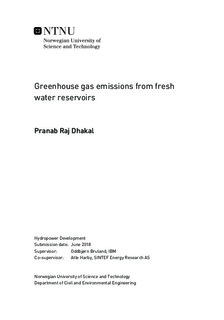Greenhouse gas emissions from fresh water reservoirs
Master thesis
Permanent lenke
http://hdl.handle.net/11250/2558600Utgivelsesdato
2018Metadata
Vis full innførselSamlinger
Sammendrag
Different sources has been used for the production of energy and each of them have their own carbon footprint. Hydropower is a renewable source of energy, the hydropower reservoirs are therefore expected to have lower net Greenhouse Gas (GHG) emission in comparison with non-renewable sources like coal and gas. Hydropower reservoirs have wide range of emissions based on various factors such as climate zone, soil carbon content, reservoir depth, Global Mean Horizontal Radiance, etc. In this report, the annual gross emission from the Norwegian reservoirs is calculated and it is 536*103 tonnes per year. The average GHG emission intensity in Norway is 3.8 g CO2eqv/ kWh. In addition, the GHG Reservoir (G-Res) tool was used to calculate the emissions from Follsjø and Svartevatn reservoirs in Norway, Banja reservoir in Albania and Nam Gnouang reservoir in Laos. The result from the G-Res tool was compared with the field measurement results done by SINTEF. It is recommended that the G-Res tool develops an emission curve for the lifetime of the reservoir along with the information of average annual GHG emission that it generates now. It is further recommended to develop a factor of correction for field emission measurement just after the spring ice-breakage. A research on the soil carbon content of impoundment under the reservoir would be very helpful to calculate GHG emissions. Finally, the stakeholders of hydropower industries are recommended to invest in the field of relevant industrial research, and on the quantification of the GHG emission from the reservoirs to enhance competitiveness of the hydropower industry in terms of GHG emission intensity per KWh against other sources of energy.
